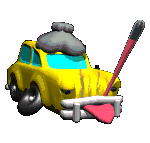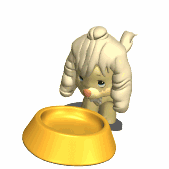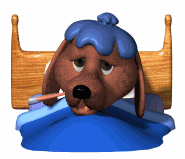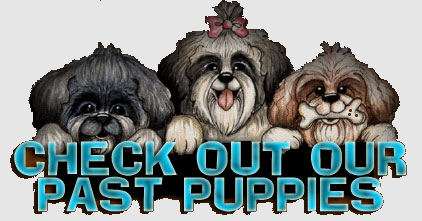Preparing You

Preparing For Your Puppy
"Creating healthy shorkie puppies one generation at a time!"
What you'll need
Get the supplies and equipment you'll need. Here's a list:
- BUY A SMALL PLAY PEN AT ANY WALMART TO USE FOR THE FIRST MONTH
- Easily washable, hard-to-destroy bedding material, imitation sheepskin works well¡ø tip-proof, stainless steel or hard plastic food & water dishes.
- Buckle puppy collar & lead; I like the soft braided nylon types.
- ID Tag with your phone number to wear on the collar
- a collection of high quality, safe chew toys: Puppy Nylabones, Cressite rubber balls or bones and sturdy stuffed squeak toys.
- grooming supplies: metal comb slicker brush and ear cleaner.. no special brand. Puppy shampoo only and brand and puppy wipes for in between washes.. Only wash every two to three week.. unless otherwise necessary. Don't want to dry out the skin.
- a quality brand of dry puppy food. LIFES ABUNDANCE ORDER FROM THE DOG FOOD PAGE
- Bitter Apple", a safe spray-on product to discourage chewing on inappropriate objects.
- a wire, wooden or plastic baby gatefor blocking doorways.
- a good book on puppy care & training . Read through them before bringing your puppy home.
Puppy-proof your home.
Raising a puppy is a lot like raising small children -- they get into everything! Some of what they get into can be hazardous to their health or to your possessions. You can make life safer for the puppy and your furniture by getting rid of hazards and temptations ahead of time.
To a puppy, the world is brand new and fascinating! He's seeing it all for the very first time and absolutely everything must be thoroughly investigated. Puppies do most of their investigating with their mouths -- "Look at this! What is it? Something to eat? Something to play with?" Murphy's Law says that a puppy will be most attracted to the things he should least have -- electrical cords, the fringe on your expensive oriental rug, your brand new running shoes, etc.
Preventing destructive and dangerous chewing is easier than trying to correct the puppy every second. Look around your home. What objects could be put up out of the way of a curious puppy? Bitter Apple spray can be applied to furniture legs, woodwork and other immovable items. Are there rooms your puppy should be restricted from entering until he's better trained and more reliable? Install a baby gate or keep the doors to those rooms closed.
Take a walk around your yard looking for potential hazards. If your yard is fenced, check the boundaries and gates for openings that could be potential escape routes. Puppies can get through smaller places than an adult dog. If your yard's not fenced, make a resolution right now that your puppy will never be allowed to run off lead without close supervision. He won't ever know enough to look both ways before crossing the street to chase a squirrel. Keep him safe by keeping him on leash!
Use a schedule
Work out a schedule for you and the puppy. Housetraining is much easier when the puppy's meals, exercise and playtimes are on a regular schedule throughout the day. Housebreaking is a whole subject in itself, one there isn't time for in today's short column. Your book on puppy care and training should have a section on housebreaking with suggestions and a recommended schedule. Read through it and create a game plan before the puppy arrives. Many people like to bring their puppies home on a weekend in order to devote extra time to settling in and housebreaking those first few days.
Everybody needs their own place
Decide where to put the dog crate, and have it set up and ready for his arrival. Where to keep the crate will depend on what's most convenient for you as well as the puppy's response. Many puppies don't like to be isolated in one part of the house while their family is in another but some puppies won't settled down in their crates if there's too much activity going on around them. You might have to experiment with different locations until you learn what works best for both you and the puppy.
Visit your vet
Make an appointment with your veterinarian to give the puppy a complete checkup within 72 hours of your purchase. If you don't have a vet yet, ask the breeder or local kennel club for a recommendation. Although the puppy has most likely been health-checked by the breeder (or should've been!), an exam is additional security against health defects, problems that weren't apparent the first time. If your vet offers microchip ID implants, this an excellent time to get one!

Car Sickness:
Car sickness is common among puppies. It is a good idea to bring paper towels just in case. Holding the puppy in your lap may help him feel more secure and help prevent car sickness. Car sickness generally decreases with age and more frequent car trips.

Starting Out:
Your puppy has just entered a whole new world. Sights, sounds, smells, people... all are new to him. Allow him to explore his new surroundings with as little restriction as possible. Treat him with "kid gloves", talk softly, move slowly, cuddle and play with him. All of this will help him learn that he is home.

Feeding Your Puppy:
The first rule in feeding your puppy is to chose a good quality dog food.We use LIFES ABUNDANCE! You can order it from our dog food page. Most major name brand feeds use good quality ingredients and are a wise choice. Off brand feeds, those named for the store that sells them or unknown companies products may have the same type of ingredients but the quality will be less. In other words you get what you pay for.
There are two ways to go about feeding your puppy. One it to "free feed" which means food is always available to him. The other is to use a feeding schedule, breaking his daily amount into several different feedings. Choose the feeding option that best fits your schedule.
For people who stay at home and want to potty train their puppy the best choice is a feeding schedule. Take your puppy outside 15 minutes after each of his 3 or 4 daily feedings. Eventually this will become a learned habit and he will want to go outside regularly. As he grows older he will only require feeding once a day but will already understand that his potty place is outside. (Or on the paper if you go that route). For paper training we recommend "Wee-wee pads". Placing him on the pad after each feeding. Once he's used to the pad you can make a slow conversion to paper by first covering the pad with the paper and eventually using paper only. It is a wise idea to make the puppy's last meal in the early evening to prevent any night time accidents. Also if your puppy gulps his food when you feed it (sometimes making himself sick) he's probably not getting enough food or not getting it often enough, making him think he has to hurry or it won't be there.
For free feeding simply leave the puppy's food in an area readily available to him. If you find your puppy seems over weight cut back on the amount of food given each day. It is still a wise idea to take up the puppy's food in the early evening to avoid a night time accident.
Puppies digestive systems were not designed for "people food". There are plenty of snacks and treats available to purchase that will make him happy and not hurt him in any way. There are two major no-no's milk and chocolate. Both of these will not only make your puppy sick but can kill him.

Hypoglycemia:
If you are going to become a toy dog owner you will want to familiarize yourself to the symptoms of hypoglycemia. Hypoglycemia is often seen in young toy puppies, and most of the time the symptoms can be controlled by eating, or by giving some glucose such as honey water to the puppy. Glucose is what the body uses as fuel and is necessary for the brain tissue and muscles to function. Hypoglycemia is when the blood sugar levels (glucose) fall well below normal. It can cause your puppy to become confused, disoriented, drowsy, have the shivers, stagger about, collapse, fall into a coma, or have seizures. Episodes of hypoglycemia often occur without warning. A puppy may be stressed by shipping, or a missed meal, being chilled, or even exhaustion from too much play. Because of their tiny size toy puppies cannot eat a lot at one time, and literally run out of fuel quickly. Puppies should be fed several times a day a high quality diet. Most puppies will outgrow the problem. Some very tiny dogs will continue to have bouts of hypoglycemia through out their life. If your puppy experiences episodes of hypoglycemia it is important to restore the blood levels of glucose as quickly as possible. Typical symptoms:
- weakness
- listlessness
- depression
- staggering gait
- tremors
If your puppy is conscious, give him/her a little White Karo Syrup, or Honey under its tongue, or rubbed on its gums. Do NOT pour into the mouth as the puppy could easily choke. You can also mix honey, or corn syrup with pedialite, stir to dissolve, and dribble it into the puppy's mouth. Nutrical also works extremely well in an emergency. The puppy should begin to improve within about ten minutes, if not contact your vet as quickly as you can.
NOTE: BREEDERS CAN NOT BE RESPONSIBLE FOR HYPOGLYCEMIA
Parvo:
- Definition: A very common and very serious viral disease in dogs. The virus is officially known as Parvovirus. The disease caused by this virus is commonly referred to as "Parvo".
- Physiology: Parvovirus affects puppies much more frequently than it affects adult dogs. The virus likes to grow in rapidly dividing cells. The intestinal lining has the biggest concentration of rapidly dividing cells in a puppy's body. The virus attacks and kills these cells, causing diarrhea (often bloody), depression and suppression of white blood cells -- which come from another group of rapidly dividing cells. In very young puppies it can infect the heart muscle and lead to "sudden" death.
- Causes: Canine parvovirus is carried by dogs. Adult dogs may be infected carriers without showing any clinical signs. Dogs with the typical diarrhea that parvovirus causes shed the virus as well. It can last a long time in the environment, perhaps as long as 9 months or longer.
Generally, it takes 7-10 days from the time of exposure for dogs and puppies to start showing symptoms and to test positive for parvo. Parvo is highly contagious to unprotected dogs. It is recommended that puppies receive a preventative shot at 6, 9, 12, and 15 weeks of age. Even puppies who have been vaccinated on a regular basis are not protected until they are 18 weeks old. Parvovirus can remain infectious in ground contaminated with fecal material for five months or more if conditions are favorable. Extremely hardy, most disinfectants cannot kill the virus, however chlorine bleach is the most effective and inexpensive agent that works, and is commonly used by veterinarians.
The ease with which infection with Parvo can occur in any unvaccinated dog must be stressed. The virus is extremely hardy in the environment. With standing wide temperature fluctuations and most cleaning agents. Parvo can be brought home to your dog on shoes, hands and even car tires. It can live for many months outside the animal. Any areas that are thought to be contaminated with parvo should be thoroughly washed with chlorine bleach diluted 1 ounce per quart of water. Dogs and puppies can contract parvo even if they never leave their yards. Parvo virus, despite what you might hear, is NOT an airborne virus. It is excreted in the feces of infected dogs, and if someone -- human, dog, bird, etc. -- steps in (or otherwise comes in contact with) the excrement, the possibility for contamination is great. Some people speculate that birds invading a dog's food dish can deposit the parvovirus there. If you think you may have come in contact with parvovirus, a strong solution of bleach and water does kill the virus, so you can wash your shoes and clothes, even your hands with it, to reduce the risk of infecting your dog. Rest assured that parvovirus is specific to dogs alone and cannot be transmitted to humans or other pets.
Signs: When dogs and puppies contract parvo, they often have diarrhea - usually bloody foul-smelling, vomiting and lethargy. Symptoms usually begin with a high fever, depression, and loss of appetite. In many cases, dehydration, shock, and death follow.
Treatment: The best form of treatment is prevention. DO NOT TAKE YOUR PUPPY OUT OF YOUR HOME WHERE IT CAN INFECT OR BE INFECTED UNTIL IT HAS HAD ALL OF IT'S PUPPY SHOTS! By isolating your puppy you may be saving it's life!
Without intense treatment, the puppy will die of dehydration. Treatment generally consists of IV or subcutaneous fluids and antibiotics. There is no cure for Parvo. Veterinarians can only treat the symptoms aggressively, and try to keep the dog alive by preventing dehydration and loss of proteins. Because there is no cure for any virus, treatment for parvo is mostly that of supporting the different systems in the body during the course of the disease. This includes giving fluids, regulating electrolyte levels, controlling body temperature and in severe cases giving blood transfusions when necessary. Parvo strikes fast and without mercy.

Call Us Anytime
If you are a looking for a website email me at pricelesspups@yahoo.com www.pricelesspups.net
shorkie Information is available and also owns:
www.crazy4shorkies.com
www.shorkielove.com
www.myshorkie.com
www.shorkieclubofamerica.com
www.officialshorkie.com
www.shorkietails.com
www.shorkiepuppies.com
www.pricelesspups.net Disclaimer
These shorkie websites contain proprietary material that is or may be protected by United States and international copyright law, trademark law, trade secret law, and other intellectual property laws. All rights not granted to you herein are expressly reserved by us www.pricelesspups.net
All content within this shorkie website and the listed shorkie websites including but not limited to all text, graphics, images, design, icons, source code, software and other copyrightable elements including the selection, ordering and arrangement thereof are the exclusive property of www.pricelesspups.net and /or their respective owners.
www.pricelesspups.net reserves all rights in these shorkie domain names and shorkie websites, trademarks, service marks and logo. The www.pricelesspups.net name and logo are trademarks or service marks of www.pricelesspups.net and may not be reprinted or displayed in any form without our express written permission of the owners.
Users may not disassemble, reverse engineer, rent, lease, sell, sub-license or create derivative works from this website, including all material, content, source code and software made available on this website or the websites listed. Users may not copy, modify, reproduce, republish, distribute, display or transmit any portion of this website or the websites listed. www.pricelesspups.net makes no claim to original U.S. government works which may appear or used on this website. Any unauthorized use of this website or its content is expressly prohibited and will be followed up upon.
Check out our shorkie puppies from the Shorkie Expert,
We dont have shorkie puppies for sale. We have shorkies for adoption!
We have shorkie pups available now !!!
We are a Shorkie breeder of Official Shorkies
Adopt a Shorkie puppy using the Shorkie Club Of America Standards.
We Shorkie Breeders that you can count on.
|
We have a shorkie or Shorkie puppies that live in or around
|
- Arizona
- Phoenix
- Arkansas
- Little Rock
- California
- Sacramento
- Colorado
- Denver
- Connecticut
- Hartford
- Delaware
- Florida
- Dover
- Tallahassee
- Georgia
- Atlanta
- Hawaii
- Honolulu
- Idaho
- Boise
- Illinois
- Springfield
- Indiana
- Indianapolis
- South Carolina
|
- Iowa
- Des Moines
- Kansas
- Topeka
- Kentucky
- Frankfort
- Louisiana
- Baton
- Rouge
- Maine
- Augusta
- Maryland
- Annapolis
- Massachusetts
- Boston
- Michigan
- Lansing
- Minnesota
- St. Paul, Mississippi
- Jackson
- Missouri
- Jefferson City
- Montana
- HelenaNebraska - Lincoln
|
- Nevada
- Carson City
- New Hampshire
- Concord
- New Jersey
- Trenton
- New Mexico
- Santa Fe
- New York
- Albany
- North Carolina
- Raleigh
- North Dakota
- Bismarck
- Ohio - Columbus
- Oklahoma
- Oklahoma City
- Oregon
- Salem
- Pennsylvania
- Harrisburg
- Rhode Island
|
- Columbia
- South Dakota
- Pierre
- Tennessee
- Nashville
- Texas
- Austin
- Utah
- Salt Lake City
- Vermont
- Montpelier
- Virginia
- Richmond
- Washington
- Olympia
- West Virginia
- Charleston
- Wisconsin
- Madison
- Wyoming
- Cheyenne
- Providence
|